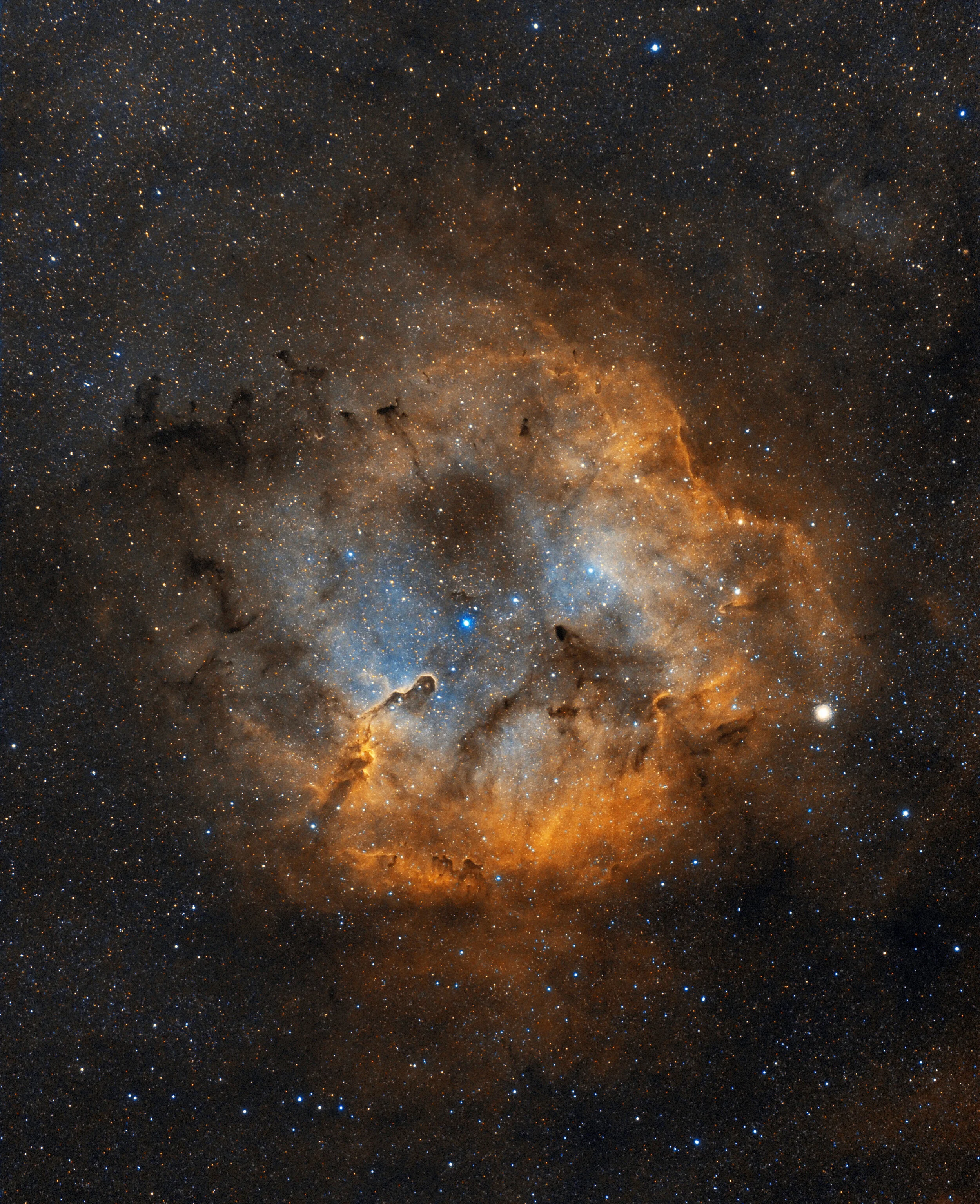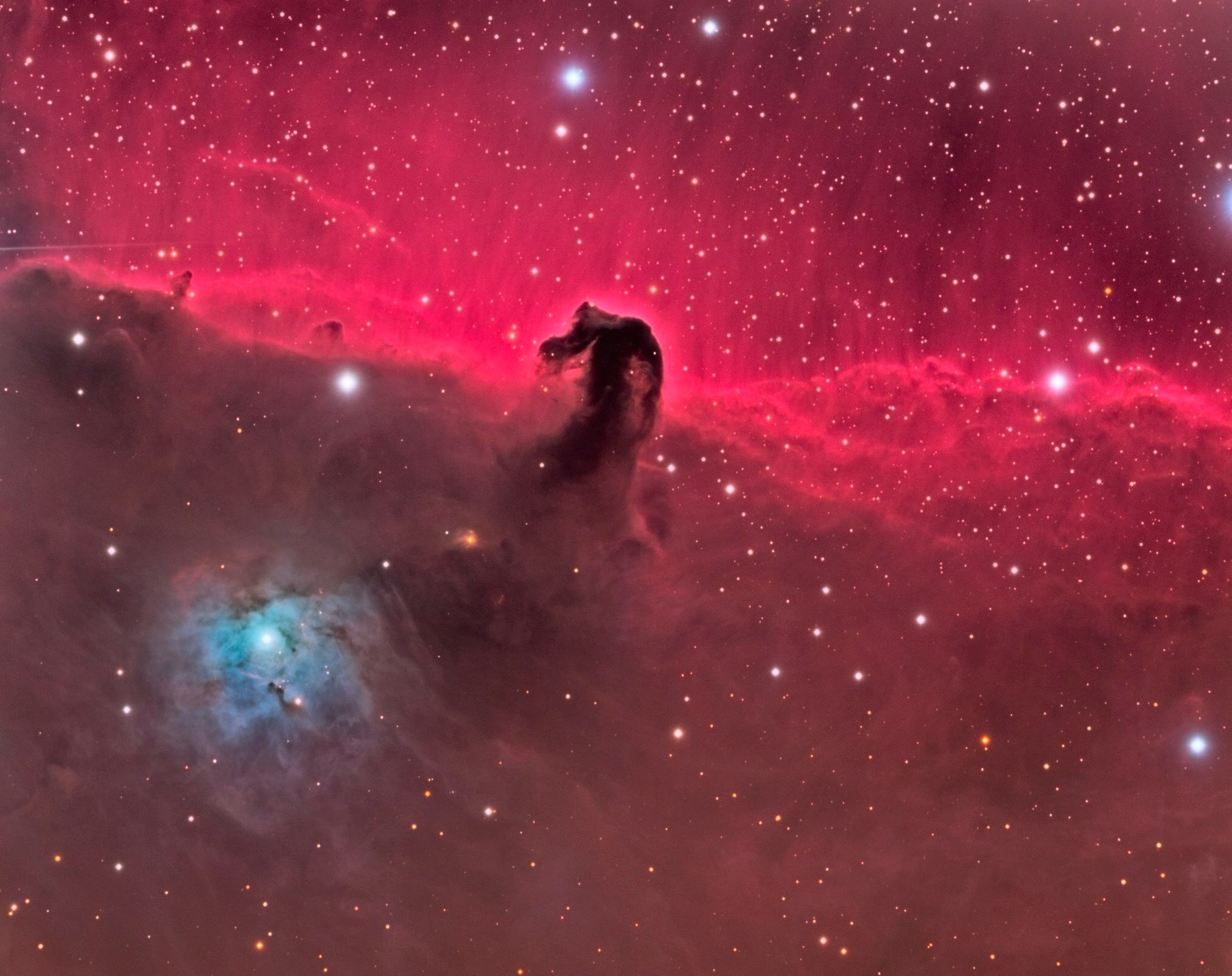
AAPOD2 Image Archives
LBN438
LBN438 is a galactic dark nebula in Lacerta. It is the molecular cloud shown in the middle of the image. Above, a nice spiral galaxy, PGC 69439 can be seen.The bright red nebula on the right side is SH2-126, a large emission nebula. LBN440, LBN435 are also in view. Image taken on September 24-26 2020 at the remote observatory at the E-Eye site in Spain.
The image is composed of 296*180 seconds with a ZWO ASI-2600MC using a Takahashi Epsilon 180 ED Astrograph, riding on a Paramount ME II.
Copyright: Maarten Vlh
The Elephant Trunk Nebula, IC1396, in Cepheus. H,H+O,O Palette
Image Description and Details :
The Constellation Cepheus is often in the shadow of the Hydrogen rich constellation of Cygnus but within its boundaries it really has a little bit of everything, such a varied bunch of targets. However, there is clearly a crowning jewel among the many rough diamonds. That is IC1396, the Elephant Trunk nebula. It’s a nebula that gives great color and contrast, with great areas of dust and the magnificent detail of the central trunk reaching in to the well of Oxygen that lies at its center. Around 5 hours of 600s subs stacked in DSS. Processed entirely in PhotoshopZWO ASI1600MC Pro, Unity Gain, -15CCanon EF L 70-200mm f/2.8 at 200mm f/4iOptron CEM25PZWO ASI120MM-S guide cameraZWO 60mm guide scopeRadian Triad Ultra Quadband 2” OSC FilterImages captured by APT, guided by PHD2, shot under Bortle 7 skies in my back garden from New Years Eve 2019 to mid January 2020
Copyright: AstroPhotoRoss
NGC 1333 Embryo Nebula
NGC 1333 Embryo Nebula in the constellation Perseus.
The NGC 1333 reflection nebula and its associated dark cloud L1450 (also known as Barnard 205) are located at the northern end of a degree-long, north-south ridge of CO emission in the Perseus region at the west side of a large cavity in the Perseus molecular cloud.
L-channel - 36 x 600 sec. bin 1x1;
R-channel - 25 x 600 sec. bin 1x1;
G-channel - 25 x 600 sec. bin 1x1;
B-channel - 25 x 600 sec. bin 1x1.
Total integration time - 18:30 hours.
My setup: Telescope 8" Celestron Schmidt-Cassegrain (SCT) CPC800 GPS (XLT) on the equatorial wedge, focal reducer Starizona 0.75x, Feq.= 1626mm, camera Starlight Xpress Trius SX694, SX mini filter wheel, filters Astrodon LRGB E-series gen.2 .
Capture and processing software: MaxIm DL6, PHD2, PixInsight, StarTools, Photoshop CC, Zoner photo studio 14.
North at the top.
Copyright: Boris Vladimirovich
IC410 - Tadpoles nebula
IC 410 and surrounding Nebula. With and without stars. Imaged on multiple nights with a total exposure time of 27.8 hours.
Telescope: Takahashi FSQ-106EDX IV
Camera: QSI 683wsg-8
Mount: Software Bisque Paramount MX+
Astrodon Ha: 37x900" -20C bin 1x1
Astrodon OIII: 37x900" -20C bin 1x1
Astrodon SII: 37x900" -20C bin 1x1
Integration: 27.8 hours
Copyright: Craig Patterson
The Heart of the Eastern Veil
Telescope: TEC APO140FL
Camera: QHY16200A
Mount: 10micron GM1000HPS
Acquisition data:
Integration: 31 hours
Frames: Astrodon 3nm Ha: 62x900" -20C bin 1x1, Astrodon 3nm OIII: 62x900" -20C bin 1x1
Location: Sammamish, WA, United States
SGPro and PHD2
Aug 2019
Processing: AstroPixelProcessor and PixInsight.
Copyright: Alex Pinkin
The Monkey Head Nebula - NGC2174
The monkey head nebula - ngc2174 is an emission nebula located in the Orion Constellation. It is associated with the stellar cluster ngc2175. It was given this name as you can see well from the photo, the face of a monkey.
I decided to process this photo with the Hubble Palette technique, and therefore, with fake colors to highlight better the emission areas of the various chemical elements that compose the nebula.
Optolong Astronomy Filter
Qhyccd
Technical Information:
Telescope: AIRY APO 130T
Mount: Paramount MyT - Software Bisque
Room: qhy9
Filter: Optolong H-A 7 NM, oiii 6.5 NM, be 6.5 NM
Frames: H-a: 32 x900s -- oiii: 32 x900s -- SII:32x900s
Total Integration: 24 Hours
Software: SGP – TheSkyX – PHD2 – DSS -PixInsight – CS6
Location: Noventa di Piave (Venice) 4 meter above sea level – ITALY
Environment Temperature: About 2°C
Relative Humidity: 88%
Date: 29.12.19 - 30.12.19 - 31.12.19 - 01.01.20
Copyright: Francesco Battistella
SH2-174 - Valentine Rose
Sh2- 174 Planetary Nebula in the cepheo, also known as "Valentine's rose". filming started in April 2018 and finished in October 2019.
Location: San Romualdo - Ravenna
Tecnosky There 130/900
Asa Ddm60pro - Non-guided poses
CCD CCD 520 WSI Cooled-15
RGB the I-SERIES AND NARROWBAND 5 NM
HA-OIII-RGB: H-alpha 43 x10min, OIII 29 x10min, R 26 x5min, G 27 x5min, B 30 x5min
Acquisition: Maximdl5 - calibrated with dark, bias and flat.
Processing: Maximdl5, Astroart6, Paint Shop Pro2020, Plugin Topaz and starspikepro3.
LBN 576 - Abell 85 and CTB 1
Telescope Tecnosky 100Q F 5.8
CCD Moravian G3 16200
Ioptron CEM120EC
H-alfa 13X1800S Bin 1X1
OIII 10X1800S Bin 2X2
11 Dark 11 Flat 11 Bias
Processing Pixinsight
Gualdo Tadino (PG) Italy
SQM: 19.50/19.90
Copyright: Ciavaglia Francesco
Banard 7 & more
Imaging telescope: Celestron 11" Rowe-Ackermann Schmidt Astrograph
Imaging camera: QHYCCD QHY367C
Mount: Orion Atlas Pro AZ/EQ-G
Guiding:Astromania 60mm Guide Scope & QHYCCD QHY5III178M
Filter:Astronomik L2 UV/IR Cut
Dates:Nov. 29, 2019, Dec. 15, 2019
Frames: 410x60"
Integration: 6.8 hours
Bortle Dark-Sky Scale: 5.00
Mean SQM: 19.68
This is a very interesting area in the Taurus Molecular Cloud featuring many dark and reflection nebulae. The main subject in the center is Barnard 7 (the dark nebula) and LBN 782 (the blue reflection nebula). To the left side is vdB 27, illuminated by RY Tauri, a young variable star. To the right is another reflection nebula illuminated by variable star CW Tauri. Peeking through the dust 186 million light years away is the galaxy IC 359, in the bottom right. All in all, a lot of different things to see here!
Copyright Jarrett Trezzo
Rosebud Nebula - NGC 7129
The young open star cluster NGC 7129 is embedded in the bluish reflection nebula vdB 146. Due to it's shape the reflection nebula is called "Rosebud Nebula" and is located in the constellation Cepheus. The young stars have blown a large, oddly shaped bubble in the molecular cloud that once surrounded them at their birth. The rosy pink color comes from glowing dust grains on the surface of the bubble being heated by the intense light from the young stars within. Also some Herbig-Haro objects can be identified in the reflection nebula. Their shape and pinkish red color is characteristic of glowing hydrogen gas shocked by jets streaming away from newborn stars.
NGC 7142 is an open cluster about 6,200 light-years away. With an estimated age of 4.5 billion years, he is one of the oldest known open clusters.
The fine Halpha filaments on the left side of the image are part of the supernova remnant SNR 110.3 + 11.3.
Scope: ASA 10" Astrograph
Mount: ASA DDM60
Camera: Moravian G3-16200 with Astrodon LRGB and Halpha filters
Total exposure time: ~81h
Copyright: Thomas Henne
The Wizard Nebula - NGC 7380
Image data:
Date: 25/10/2019 and 26/10/2019
Site: Albox - Almería - Spain
Image Details: H-Alpha: 24x600" / OIII: 15x600" / SII: 24x600"
Telescope: Teleskop-Service Imaging Star 130mm f/5 - 6-elements Flatfield APO
CCD: ASI1600MMC
CCD Guiding: QHY5L-II
Capture and guiding software: MaxIm DL
Mount: Celestron CGEM
Processing: PixInsight
Bias, Darks and Flats applied
https://www.astrobin.com/m784zo
Copyright: José Francisco del Aguila del Aguila
Cygnus Mosaic
Cygnus mosaic
Image data:
Dates: 21.09.2019, 03.10.2019, 23.10.2019, 26.10.2019
Camera: Canon EOS 6DMod
Lens: Samyang 135/F2@F2
Mount: SkyWatcher Star Adventurer (no guiding)
Exposure: 144x120" ISO 800 (six panels, 24 subframes per panel)
Location: Czech Republic, Stranske
Processing: Astropixel procesor, Adobe PS Creative Cloud
Copyright:
Copyright: Martin Vyhlidal
Horsehead Nebula - B33
Horsehead Nebula LRGB, Ha. Taken from PixelSkies, Spain www.pixelskiesastro.com
This target was what got me into Astrophotography many years ago but I could never do it justice in the UK with the light-polluted skies in Birmingham so now living in Spain and running a Remote Telescope Hosting site I have been able to collect better quality data and do it more justice.
Lum 25x900Secs
Red 48x300Secs
Green 19x300Secs
Blue 20x300Secs
Ha 81x1200Secs
40 hours 35 mins in total.
Equipment used:
Telescope: Tec 140 F7
Camera: Xpress Trius SX-694 Mono Cooled to -10C
Image Scale: 0.95
Guiding: OAG
Filters: Astronomik LRGB, Ha
Mount: iOptron CEM60 "Standard" GOTO Centre Balanced Equatorial Mount
Image Acquisition: Voyager
Observatory control: Lunatico Dragonfly
Stacking and Calibrating: Pixinsight
Processing: Pixinsight 1.8
Copyright: David Wills
IC 5067
Image Description and Details: MT 300 SkyVision F / D 3.3 Astrograph Telescope Instrument with Paracorr Type 2
Imager CCD camera QSI 540WSG, temperature -15 °, Atik GP guidance
Exposure 16 X1200 sec in H alpha, 5 x 600 sec in RGB
MaxIm DL 5 pre-treatments
MaxIm DL 5 and Photoshop CS3 processing
Conditions SQM 20.92, fairly good transparency, wind 28 km / s
The Pelican Nebula (IC 5067 and IC 5070) is an emission nebula located approximately 2,000 light years from Earth in the constellation Cygnus. It is very wide in the sky, making approximately 2.5 times the diameter of the Moon.
Copyright: Alexandre Cucculelli
Dolphin Head Nebula -Sh2-308
Image Description and Details : Here is my first object captured in 2020.
This is the dolphin head nebula, Cataloged Sharpless SH 2-308, it is about 5,200 light-years from home towards the constellation of the Big Dog.
The massive star (Wolf-Rayet type) that created the bubble is the bright star located near the center of the nebula.
It generates a powerful radiation which drives out the gas around thus creating a giant bubble.
Technical details :
• TS 102mm F5,1 apo astrograph bezel
• Azeq6gt mount
• Zwo asi 1600 mm cooled pro
• Sampling: 1.47 arcsec / pixel.
Frames:
Astronomik 6nm OIII 36mm: 93x300" -10C
Astronomik HA 6nm 36mm: 17x300" -10C
ZWO B 36mm: 27x60" -10C
ZWO G 36mm: 27x60" -10C
ZWO R 36mm: 27x60" -10C
Integration: 10.5 hours
• DOF: 15x101x0
• Date: January 1 and 2, 2020
• Location: MAO Observatory of Ben Slimane.
Copyright: Aziz Kaeouach
The North American And Pelican Nebulae
The North American And Pelican Nebulae.
Taken with a Takahashi FSQ106 and SBIG 11000m.
45 hours total exposure.
Copyright: Wayne Jaeschke
Mosaic in Sagittarius
305mm Reflector + AZ / EQ-6.
Canon 6D mod.
Cooling box.
Coma corrector.
Cls-ccd filter
48 x 300 ISO 1600
Copyright: Adriano de Oliveira
The Shark Nebula (LDN1235)
This image shows the Shark Nebula (LDN1235) in the constellation of Cepheus.
This is a nice cloud of gas and dust which is highlighted by the light of nearby stars.
Telescope: TMB92 @ f/5.5
Camera: QSI583ws
Mount: Skywatcher EQ6
Exposures:
L: 53 x 600s
R: 9 x 600s
G: 9 x 600s
B: 9 x 600s
Total: 13,3 hours
Copyright: André Van Der Hoeven





















